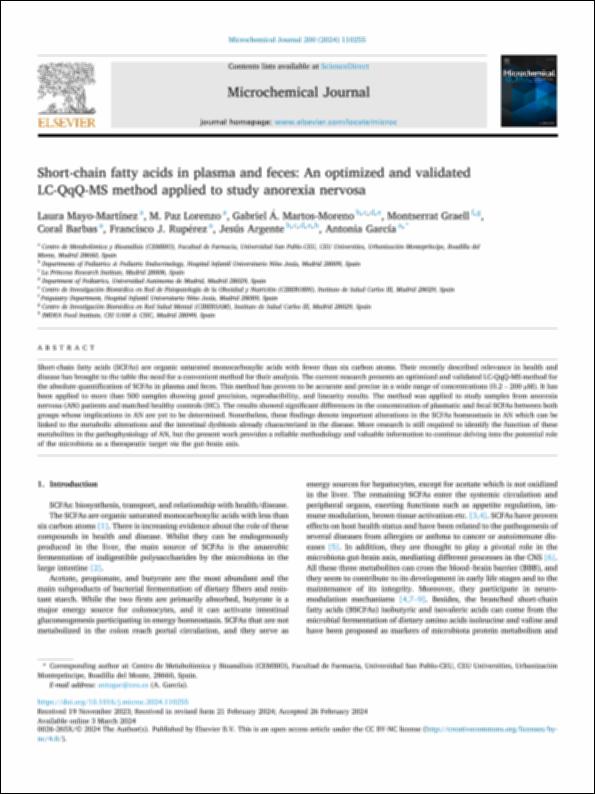Por favor, use este identificador para citar o enlazar este ítem:
http://hdl.handle.net/10637/15734Short-chain fatty acids in plasma and feces: An optimized and validated LC-QqQ-MS method applied to study anorexia nervosa

Ver/Abrir:
Short_Mayo_et_al_MicroJour_20224.pdf
4,12 MB
Adobe PDF
Ver/Abrir:
Short_Images_Mayo_et_al_MicroJour_2024.pdf
234,54 kB
Adobe PDF
| Título : | Short-chain fatty acids in plasma and feces: An optimized and validated LC-QqQ-MS method applied to study anorexia nervosa |
| Autor : | Mayo Martinez, Laura Lorenzo García, María Paz Martos Moreno, Gabriel Á. Graell, Montserrat Barbas Arribas, Coral. Rupérez Pascualena, Francisco Javier Argente, Jesús García Fernández, Antonia |
| Materias: | Organic saturated monocarboxylic; Acids |
| Editorial : | Elsevier |
| Citación : | Laura Mayo-Martínez, M. Paz Lorenzo, Gabriel Á. Martos-Moreno, Montserrat Graell, Coral Barbas, Francisco J. Rupérez, Jesús Argente, Antonia García, Short-chain fatty acids in plasma and feces: An optimized and validated LC-QqQ-MS method applied to study anorexia nervosa, Microchemical Journal, Volume 200, 2024, 110255, ISSN 0026-265X, https://doi.org/10.1016/j.microc.2024.110255. |
| Resumen : | Short-chain fatty acids (SCFAs) are organic saturated monocarboxylic acids with fewer than six carbon atoms. Their recently described relevance in health and disease has brought to the table the need for a convenient method for their analysis. The current research presents an optimized and validated LC-QqQ-MS method for the absolute quantification of SCFAs in plasma and feces. This method has proven to be accurate and precise in a wide range of concentrations (0.2 – 200 µM). It has been applied to more than 500 samples showing good precision, reproducibility, and linearity results. The method was applied to study samples from anorexia nervosa (AN) patients and matched healthy controls (HC). The results showed significant differences in the concentration of plasmatic and fecal SCFAs between both groups whose implications in AN are yet to be determined. Nonetheless, these findings denote important alterations in the SCFAs homeostasis in AN which can be linked to the metabolic alterations and the intestinal dysbiosis already characterized in the disease. More research is still required to identify the function of these metabolites in the pathophysiology of AN, but the present work provides a reliable methodology and valuable information to continue delving into the potential role of the microbiota as a therapeutic target via the gut-brain axis. |
| URI : | http://hdl.handle.net/10637/15734 |
| Derechos: | http://creativecommons.org/licenses/by-nc/4.0/deed.es Open Access |
| ISSN : | 1095-9149 |
| Cubierto por: | Acuerdo Transformativo - 2024 |
| Fecha de publicación : | 3-mar-2024 |
| Centro : | Universidad San Pablo-CEU |
| Aparece en las colecciones: | Facultad de Farmacia |
Los ítems de DSpace están protegidos por copyright, con todos los derechos reservados, a menos que se indique lo contrario.

